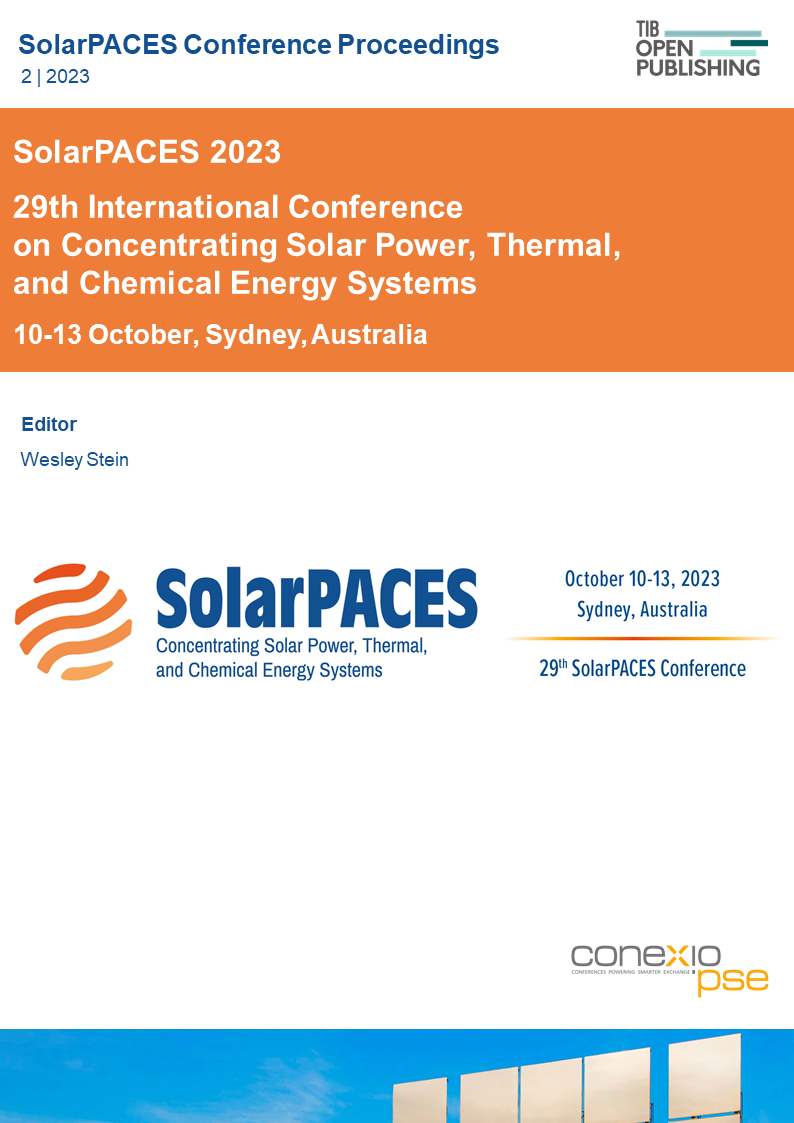A Technical-Economic Assessment of Producing Hydrogen and Biofuels via Gasification of Biomass in Solar Hybridised Dual Fluidised Bed
DOI:
https://doi.org/10.52825/solarpaces.v2i.808Schlagworte:
Solar-Hybridised Gasifier, CO2 Mitigation, Biomass-to-ChemicalsAbstract
In this work, the techno-economic performances of three conversion pathways using an upstream solar hybridised dual fluidised bed (SDFB) for biomass gasification were assessed. The annual solar share % over the solar multiple range of 1.4-3.4 varies between 7-17%, with the CO2 emissions avoided relative to the non-solar case varying between 7%-23%, using representative solar viability location in Australia. The projected break-even price varies between 5.5-6.1 AUD/kg (3.8-4.25 USD/kg) for hydrogen, 1.1-1.2 AUD/kg (0.75-0.85 USD/kg) for methanol, and 1.5-1.7 AUD/L (1.1-1.2 USD/L) for liquid fuels over the analysed oversize level of 1.4 to 3.4 at thermal storage capacity designs with less than 1% solar dumping rate for base case scenario. Overall, the derived break-even price from the SDFB gasifier configuration is higher than that of the non-solar gasifier case, yet this is dependent on the cost of supplement heat supply and carbon credit
Downloads
Literaturhinweise
[1] Saw, W.L., P. Guo, P.J. van Eyk, and G.J. Nathan, “Approaches to accommodate resource variability in the modelling of solar driven gasification processes for liquid fuels synthesis”, Solar Energy, vol. 156, pp. 101-112, 2017, doi: https://doi.org/10.1016/j.solener.2017.05.085.
[2] Rahbari, A., A. Shirazi, M.B. Venkataraman, and J. Pye, “A solar fuel plant via supercritical water gasification integrated with Fischer–Tropsch synthesis: Steady-state modelling and techno-economic assessment”, Energy Conversion and Management, vol. 184, pp. 636-648, 2019, doi: https://doi.org/10.1016/j.enconman.2019.01.033.
[3] Bai, Z., Q. Liu, L. Gong, and J. Lei, “Investigation of a solar-biomass gasification system with the production of methanol and electricity: Thermodynamic, economic and off-design operation”, Applied Energy, vol. 243, pp. 91-101, 2019, doi: https://doi.org/10.1016/j.apenergy.2019.03.132.
[4] Boujjat, H., S. Rodat, and S. Abanades, “Techno-Economic Assessment of Solar-Driven Steam Gasification of Biomass for Large-Scale Hydrogen Production”, Processes, vol. 9, pp. 462, 2021, doi: https://doi.org/10.3390/pr9030462.
[5] Guo, P., P.J. Van Eyk, W.L. Saw, P.J. Ashman, G.J. Nathan, and E.B. Stechel, “Performance assessment of Fischer–Tropsch liquid fuels production by solar hybridized dual fluidized bed gasification of lignite”, Energy & Fuels, vol. 29, pp. 2738-2751, 2015, doi: https://doi.org/10.1021/acs.energyfuels.5b00007.
[6] Jansen, D., M. Gazzani, G. Manzolini, E. van Dijk, and M. Carbo, “Pre-combustion CO2 capture”, International Journal of Greenhouse Gas Control, vol. 40, pp. 167-187, 2015, doi: https://doi.org/10.1016/j.ijggc.2015.05.028.
[7] Jeevahan, J., A. Anderson, V. Sriram, R. Durairaj, G. Britto Joseph, and G. Mageshwaran, “Waste into energy conversion technologies and conversion of food wastes into the potential products: a review”, International Journal of Ambient Energy, pp. 1-19, 2018, doi: https://doi.org/10.1080/01430750.2018.1537939
[8] Ciferno, J.P. and J.J. Marano, “Benchmarking biomass gasification technologies for fuels, chemicals and hydrogen production.”, 2002. https://www.netl.doe.gov/sites/default/files/netl-file/BMassGasFinal.pdf.
[9] Campbell, R.M., N.M. Anderson, D.E. Daugaard, and H.T. Naughton, “Financial viability of biofuel and biochar production from forest biomass in the face of market price volatility and uncertainty”, Applied Energy, vol. 230, pp. 330-343, 2018, doi: https://doi.org/10.1016/j.apenergy.2018.08.085.
[10] Kraft, S., F. Kirnbauer, and H. Hofbauer, “CPFD simulations of an industrial-sized dual fluidized bed steam gasification system of biomass with 8 MW fuel input”, Applied Energy, vol. 190, pp. 408-420, 2017, doi: https://doi.org/10.1016/j.apenergy.2016.12.113.
[11] ASTRI, “Details of 120 Mwe Molten Salt Central Receiver Plant with SCO2 Power Block”, (internal report), 2014.
[12] Aspelund, A. and K. Jordal, “Gas conditioning—The interface between CO2 capture and transport”, International Journal of Greenhouse Gas Control, vol. 1, pp. 343-354, 2007, doi: https://doi.org/10.1016/S1750-5836(07)00040-0.
[13] Peters, M.S., K.D. Timmerhaus, and R.E. West, “Plant design and economics for chemical engineers”, 5th ed., New York: McGraw-Hill, 2003.
[14] Ngo, N.K., Smith, T., Nathan, G., Ashman, P., Hosseini, T., Beath, A., Stechel, E.B., and Saw, W.L., “Techno-Economic Evaluation of Solar Hybridized Biomass Gasification Polygeneration Plants”, Energy & Fuels, vol. 38, pp. 2058-2073, 2024, doi: https://doi.org/10.1021/acs.energyfuels.3c04329.
[15] Longden, T., F.J. Beck, F. Jotzo, R. Andrews, and M. Prasad, “‘Clean’ hydrogen?–Comparing the emissions and costs of fossil fuel versus renewable electricity based hy-drogen“, Applied Energy, vol. 306, pp. 118-145, 2022, doi: https://doi.org/10.1016/j.apenergy.2021.118145.
Downloads
Veröffentlicht
Zitationsvorschlag
Konferenzband
Rubrik
Lizenz
Copyright (c) 2024 Nguyet Ky Ngo, Tara Hosseini, Peter Ashman, Graham Nathan, Woei Saw

Dieses Werk steht unter der Lizenz Creative Commons Namensnennung 4.0 International.
##plugins.generic.dates.accepted## 2024-04-08
##plugins.generic.dates.published## 2024-10-18
